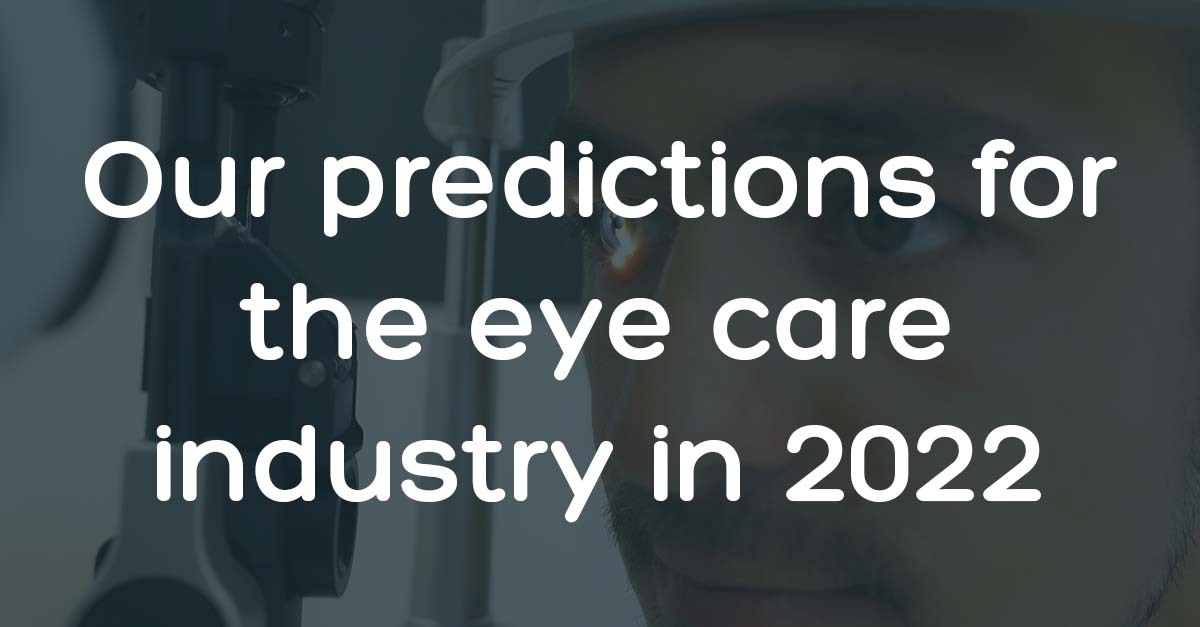Our predictions for the eye care industry in 2022
14th January 2022

2021 was another turbulent period as the eye care industry adjusted to fluctuating restrictions throughout the year as a result of the Covid-19 pandemic. 2022 can only be better, right?!
As with many industries, the crisis we’ve lived through has significantly influenced eye care. It has forced eye care professionals and organisations to innovate, and this innovation looks set to continue over the next year as practices aim to not just survive but thrive.
Digital Care Delivery
With the pandemic disrupting the ability to see patients in-person, telehealth or digital care delivery has become something of a necessity for many practices in recent times. Technological advances, such as with the AOS Vision mobile app, have meant that effective care can now be delivered remotely. Patients are now able to safely and quickly capture and transfer images and video of their eyes remotely and, thanks to the tele-optometry function, video calls between themselves and eye care professionals have become quick, easy and secure.
We come into 2022 with yet more uncertainty as coronavirus infection rates surge across the globe. Many governments are implementing restrictions once again and even in regions where restrictions remain relatively loose, populations are taking precautions of their own accord to minimise their own risk of catching and spreading the virus. As a result, the desire for remote care is unlikely to diminish in the near future.
While the practices that have already incorporated telehealth into their offering may have done so out of necessity, many are realising the positive effect it brings beyond circumventing restrictions. Practices can benefit from optimised chair time and improved time efficiency, while appointments become more convenient for the patient. For some patients, telehealth has become something of an expectation rather than a perk. However, there will be many who have yet to receive care in this format, so, if you haven’t adopted it already, telehealth will be a great way to ‘wow’ your patients in 2022!
Patients come first
While this may sound obvious, making patients the true core of your business is as important now as it has ever been before. In general terms, people are becoming ever more conscious of how businesses conduct themselves, whether that be from a customer service perspective or in more societal issues such as their impact on the environment or their employees’ working conditions.
There have never been more options for people to shop around and eye care isn’t much different. If eye care businesses hope to attract and retain patients, they must look at how they can add as much value for the patient as possible.
We discussed digital care delivery or telehealth above and that has been a great vehicle for driving patient education. Rebecca Donnelly, Clinical Lead Optometrist at Lynne Fernandes Optometrists in Bristol, UK, and recent guest on our Powered by Patients webinar series, discussed how AOS software enabled them to further educate their patients, who have become noticeably more engaged when it comes to in-person appointments as a result.
‘Patients being able to see the reports AOS provides adds so much value to an appointment, as opposed to traditionally just getting a copy of their prescription,’ Rebecca said. ‘I’ve seen patients come into the clinic a year after a remote appointment and they’re much more aware of what I’m doing and asking lots of questions – they get so much education out of the experience.’
Essentially, 2022 is the year for eye care businesses to focus on building lasting relationships with their patients. Patients are benefitting from a hybrid of in-person and remote appointments and with schemes such as monthly eye care plans, the opportunity is there to add significant value.
Artificial Intelligence and Beyond
AI is becoming ever more present in our lives, but few have pioneered in this space more than the ophthalmology industry. Imagery of patients’ eyes, such as with digital slit lamps, has become a key part of delivering effective eye care and artificial intelligence is a great way of consistently and accurately delivering positive clinical outcomes. AI has already become adept at reading these images when it comes to grading, determining how suitable a patient is for contact lens wear.
Without the use of AI tools, grading is highly subjective which can lead to inaccuracies and discrepancies with inter-clinician variability. Studies have shown reliability and accuracy between clinicians to be as low as 47%. AI grading tools, therefore, represent an objective alternative that increases accuracy to deliver improved clinical outcomes.
AI is a great and growing technology; however, it does have its limitation in practical use. Given the massive amounts of data needed to train such technology and the processing power needed to run them other technologies offer significant benefits. The AOS technology employs proprietary technology termed Digital Organelles™ which offer a unique way to objectively grade and assess images for many types of ophthalmic manifestations including contact lens fit and follow up, dry eye and other eye conditions in an online platform, with processing that is quick and light. AOS also includes multiple ways to interact with the patient including synchronous and asynchronous care via video, audio, and imagery. Additionally, while AI does offer great advantages, with the AI path leading to autonomous medical interactions, we must consider the necessity of keeping the clinician involved not only for the quality of the clinical interaction, but also for the overall health (mental wellness included) for the patient and what they expect from a medical interaction.
If there’s anything the past two years have taught us, it’s to expect the unexpected. What we can be confident in, though, is that 2022 looks to be an exciting year when it comes to innovation in the eye care industry and, here at AOS, we can’t wait to get stuck in!
By Nathan Little
Chief Strategy Officer
